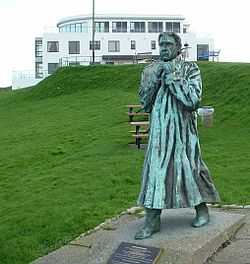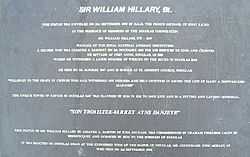William Hillary

Sir William Hillary, 1st Baronet (4 January 1771 – 5 January 1847) was an English soldier, author and philanthropist, best known as the founder of the Royal National Lifeboat Institution in 1824. He was a Yorkshire Quaker by descent, the son of Richard Hillary and his wife, Hannah Wynne.[1]
Hillary spent two years as an Equerry to Prince Augustus Frederick,[2] the young son of George III. His duties included sailing with the prince in the Mediterranean, where William Hillary learned his basic seamanship and navigation skills.
Hillary married Essex-born heiress Frances Elizabeth Disney Ffytche (or Fytche) on 21 February 1800. In the same year, their twins were born, a son, Augustus William Hillary (d. 30 December 1855)[3] and a daughter, Elizabeth Mary.[2]
Hillary's religious background did not meet with the approval of his wife's father, but Hillary still spent his wife’s inheritance (some £20,000) on creating England’s largest private army, put at the service of King George III against Napoleon’s threatened invasion. It was for this that he reputedly received his Baronetcy in 1805.
By some accounts, Hillary settled in the Isle of Man in 1808 in order to put a few miles and a little water between himself and his creditors, and to bury quietly the murkier details surrounding his elopement and marriage. In 1813, he remarried (after presumably divorcing his first wife, as she did not die until 1828,[4]) this time to a local Manx woman, Emma Tobin.[2]
Living at Fort Anne, Douglas, Isle of Man, Hillary soon became aware of the treacherous nature of the Irish Sea, with many ships being wrecked around the Manx coast. He drew up plans for a lifeboat service manned by trained crews, intended not only for the Isle of Man, but for all of the British coast. In February 1823 he published a pamphlet entitled An Appeal To The British Navy On The Humanity And Policy Of Forming A National Institution For The Preservation Of Lives And Property From Shipwreck.
Initially he received little response from the Admiralty but on appealing to the more philanthropic members of London society, including Thomas Wilson (MP for Southwark) and George Hibbert, chairman of the West Indies Merchants, the plans were enthusiastically adopted and the National Institution for the Preservation of Life from Shipwreck was founded on 4 March 1824 at a meeting in The Tavern, Bishopsgate Street, London.
The title changed 30 years later to the Royal National Lifeboat Institution and the first of the new lifeboats to be built was stationed at Douglas in recognition of Hillary's work.
St. George Rescue
At the age of 60, Hillary took part in the rescue, in 1830, of the packet St George, which had foundered on Conister Rock at the entrance to Douglas harbour. He commanded the lifeboat, was washed overboard with others of the lifeboat crew, yet finally everyone aboard the St George was rescued with no loss of life.
Following the heroic rescue, the Master of the St George, Lieut. John Tudor (RN), wrote to Sir William expressing the gratitude of himself and his crew.[5]
"My Dear Sir - Allow me to return you (in the name of the crew of the St. George and myself) our most grateful thanks for the very great personal exertions of yourself, Lieut. Robinson (RN)., Mr William Corlett and the Life Boat's crew during the gale of yesterday morning.I want words, Sir, to express to you what we then felt, and what we shall ever feel, for the noble and determined manner in which you persevered in coming to our assistance, after we had considered it our duty to warn you off, for, the vessel having bilged, the severity of the gale, the position of the wind, and the time of the tide, there did not appear to us (amongst the heavy breakers then rolling upon Conister) the slightest chance of escape for you, and which, from the crippled state of the life boat when she afterwards left the wreck, was so nearly proving to be the case. Trusting, Sir, that you may long live to preside over an establishment your philanthropy gave birth to, and in which your humanity has always placed you amongst the foremost and most active of its members - I have the honor to remain Your obliged, grateful, and Most obedient servant"
— Lieutenant John Tudor (RN). Douglas, November 21st, 1830.
At a Meeting of the Committee of the Isle of Man District Association of the Royal National Institution, for the Preservation of Life from Shipwreck, held at the Courthouse, Douglas, November 27, 1830, presided over by the Chairman, High Bailiff James Quirk Esq, it was agreed unanimously that the following report be transmitted to the Secretary of the Royal National Institution:[6]
"That the thanks of this meeting be presented to Sir William Hillary, Lieut. Robinson, William Corlett Esq, and the crew of the life boat, for their very gallant and meritorious exertions in saving the lives of the crew of the St. George."
For the saving of the 22 crew members on board the St. George, Sir William and Lieut. Robinson both received the Institution's Gold Medal (the second of three Sir William was to receive).[7] William Corlett and Issac Vondy both received Silver Medals[7] with a purse of 20 guineas also distributed to the crew in recognition of their gallantry.[7]
This incident prompted Sir William to set up a scheme to build the Tower of Refuge on Conister Rock. The structure, designed by architect John Welch was completed in 1832 and still stands at the entrance to Douglas harbour (it is the subject of a poem by William Wordsworth).[8]
As well as the Tower of Refuge, Sir William was instrumental in recommendations for the construction of a Breakwater at Douglas so as to afford the harbour greater shelter and to provide a sheltered haven to ships plying in the Irish Sea.[9] Sir William had written a paper on the proposal prior to 1835, when more formal proposals were put forward, and design plans drawn up by Sir John Rennie. Even so, it was to be a long time after Sir William's death that construction finally began.[10]
In Memorial
There are three memorials to Sir William Hillary in Douglas, Isle of Man:
- Sunken Gardens, Loch Promenade, with the following inscription:

Sir William Hillary & his volunteer crew go to the aid of the stricken St. George 20th November 1830
- St George's Church, with the following inscription:
TO THE HONOURED MEMORY OF/LIEUT. COLONEL SIR WILLIAM HILLARY, BT./OF YORKSHIRE, ESSEX AND THE ISLE OF MAN/ LIEUTENANT TURCOPOLIER OF THE ORDER OF THE KNIGHTS OF ST JOHN OF JERUSALEM./BORN 1771. DIED 1847/SOLDIER, AUTHOR, PHILANTHROPIST./HE FOUNDED IN THE YEAR 1824 THE ROYAL NAVAL LIFE BOAT INSTITUTION/AND IN 1832 BUILT THE TOWER OF REFUGE IN DOUGLAS BAY./FEARLESS HIMSELF IN THE WORK OF RESCUE FROM SHIPWRECK HE HELPED SAVE 509 LIVES/AND WAS THREE TIMES AWARDED THE GOLD MEDAL OF THE INSTITUTION FOR GREAT GALLANTRY./WHAT HIS WISDOM PLANNED AND POWER ENFORCED/MORE POTENT STILL HIS GREAT EXAMPLE SHOWED.
- Douglas Head, with the following inscription:

Sir William Hillary, Bt.This statue was unveiled on 21 September 1999 by H.R.H Prince Michael of Kent K.C.V.O.
It was erected on Douglas Head at the expressed wish of the Mayor of Douglas, Mr Councillor John Morley, J.P. who died on 3 September 1999.
In the presence of Members of the Douglas Corporation.
Sir William Hillary 1771-1847
Founder of the Royal National Lifeboat Institution.
A soldier who was created a Baronet on 8 November 1805 for his services to king and country.
He settled at Fort Anne, Douglas in 1806 where he witnessed a large number of wrecks on the rocks in Douglas Bay.
He died on 5 January 1847 and is buried at St. George's Church, Douglas.
"Followed to the grave by crowds who had witnessed his heroism and self-devotion in saving the life of many a shipwrecked mariner".
The Unique Tower of Refuge in Douglas Bay was planned by him in 1832 to save life and is a fitting and lasting memorial.
"SON TROAILTEE-VARREY AYNS DANJEYR"
This statue of Sir William Hillary by Amanda L. Barton of Kirk Michael was commissioned by Graham Ferguson Lacey of Bishopscourt and donated by him to the Borough of Douglas.
Notes and references
- ↑ For an account of his family background, see Journal of the Friends Historical Society vol. 60, No.3 pp157-179 "Quakers of Countersett and their legacy" by Christopher Booth
- ↑ 2.0 2.1 2.2 Oxford Dictionary of National Biography article by Thomas Seccombe, ‘Hillary, Sir William, first baronet (1770–1847)’, rev. Sinéad Agnew, 2004; online edn, May 2005 accessed 8 June 2007
- ↑ ThePeerage.com website
- ↑ Frances Elizabeth Hillary grave monument details
- ↑ 5.0 5.1 Manks Advertiser. Tuesday November 23, 1830
- ↑ 6.0 6.1 Manks Advetiser. Tuesday November 30th, 1830.
- ↑ 7.0 7.1 7.2 Manx Sun Tuesday December 28th, 1830
- ↑ Complete Poetry of William Wordsworth; full-text poems of William Wordsworth, at everypoet.com
- ↑ Manx Sun. Friday October 2nd, 1835
- ↑ Manx Sun. Saturday August 7th, 1858
- ↑ Maritime Memorials
ODNB article cites R. Kelly, For those in peril’: the life and times of Sir William Hillary, the founder of the RNLI (1979) as its main source.
External links
|